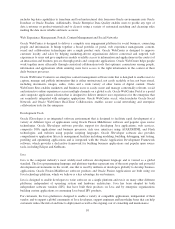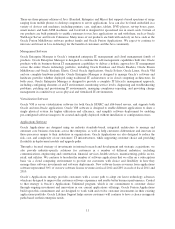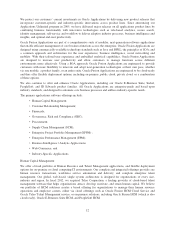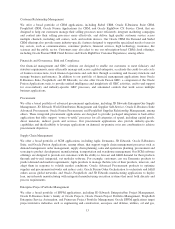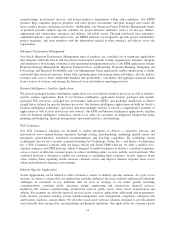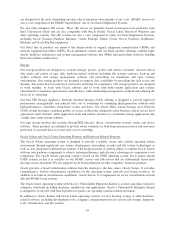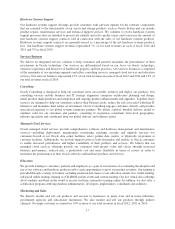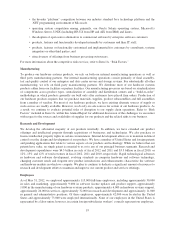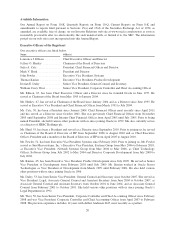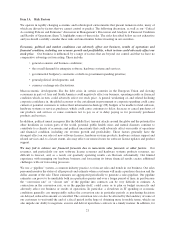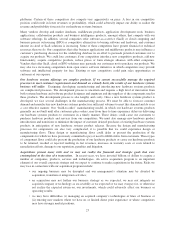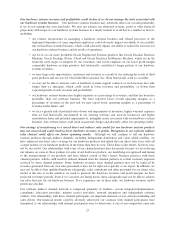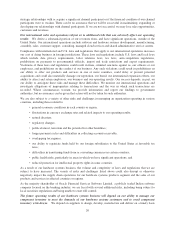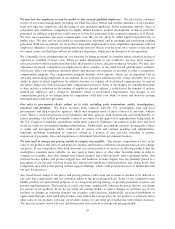Oracle 2012 Annual Report Download - page 23
Download and view the complete annual report
Please find page 23 of the 2012 Oracle annual report below. You can navigate through the pages in the report by either clicking on the pages listed below, or by using the keyword search tool below to find specific information within the annual report.• the broader “platform” competition between our industry standard Java technology platform and the
.NET programming environment of Microsoft;
• operating system competition among, primarily, our Oracle Solaris operating system, Microsoft’s
Windows Server, UNIX (including HP-UX from HP and AIX from IBM) and Linux;
• the adoption of open source alternatives to commercial software by enterprise software customers;
• products, features and functionality developed internally by customers and their IT staff;
• products, features or functionality customized and implemented for customers by consultants, systems
integrators or other third parties; and
• attractiveness of offerings from business processing outsourcers.
For more information about the competitive risks we face, refer to Item 1A. “Risk Factors.”
Manufacturing
To produce our hardware systems products, we rely on both our internal manufacturing operations as well as
third party manufacturing partners. Our internal manufacturing operations consist primarily of final assembly,
test and quality control of our enterprise and data center servers and storage systems. For substantially all other
manufacturing, we rely on third party manufacturing partners. We distribute most of our hardware systems
products either from our facilities or partner facilities. Our manufacturing processes are based on standardization
of components across product types, centralization of assembly and distribution centers and a “build-to-order”
methodology in which products generally are built only after customers have placed firm orders. Production of
our hardware products requires that we purchase materials, supplies, product subassemblies and full assemblies
from a number of vendors. For most of our hardware products, we have existing alternate sources of supply or
such sources are readily available. However, we do rely on sole sources for certain of our hardware products. As
a result, we continue to evaluate potential risks of disruption to our supply chain operations. Refer to “Risk
Factors” included in Item 1A. within this Annual Report for additional discussion of the challenges we encounter
with respect to the sources and availability of supplies for our products and the related risks to our business.
Research and Development
We develop the substantial majority of our products internally. In addition, we have extended our product
offerings and intellectual property through acquisitions of businesses and technologies. We also purchase or
license intellectual property rights in certain circumstances. Internal development allows us to maintain technical
control over the design and development of our products. We have a number of United States and foreign patents
and pending applications that relate to various aspects of our products and technology. While we believe that our
patents have value, no single patent is essential to us or to any of our principal business segments. Research and
development expenditures were $4.5 billion in each of fiscal 2012 and 2011 and $3.3 billion in fiscal 2010, or
12%, 13% and 12% of total revenues in fiscal 2012, 2011 and 2010, respectively. Rapid technological advances
in hardware and software development, evolving standards in computer hardware and software technology,
changing customer needs and frequent new product introductions and enhancements characterize the software
and hardware markets in which we compete. We plan to continue to dedicate a significant amount of resources to
research and development efforts to maintain and improve our current product and services offerings.
Employees
As of May 31, 2012, we employed approximately 115,000 full-time employees, including approximately 30,000
in sales and marketing, approximately 9,000 in software license updates and product support, approximately
1,000 in the manufacturing of our hardware systems products, approximately 6,000 in hardware systems support,
approximately 26,000 in services, approximately 32,000 in research and development and approximately 11,000
in general and administrative positions. Of these employees, approximately 42,000 were located in the United
States and approximately 73,000 were employed internationally. None of our employees in the United States is
represented by a labor union; however, in certain foreign subsidiaries workers’ councils represent our employees.
19



